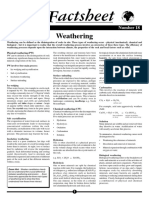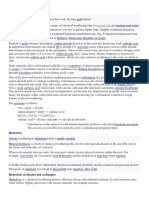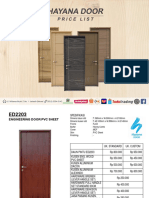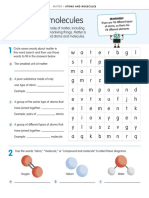Effloresence What How and Cause
Effloresence What How and Cause
Uploaded by
Zaini MahdiCopyright:
Available Formats
Effloresence What How and Cause
Effloresence What How and Cause
Uploaded by
Zaini MahdiOriginal Title
Copyright
Available Formats
Share this document
Did you find this document useful?
Is this content inappropriate?
Copyright:
Available Formats
Effloresence What How and Cause
Effloresence What How and Cause
Uploaded by
Zaini MahdiCopyright:
Available Formats
Effloresence
What, How, and Cause
OUTLINE
What is Efflorescence?
How Efflorescence Occur
Causes of Efflorescence
Preventing Efflorescence
Refferences
2 December 4, 2013 REFRACTORY TEAM
1. What is • Efflorescence is the formation of salt deposits, usually white, on or near the surface of concrete causing a change
in appearance.
Efflorescence
? • Required condition
Three condition that must be exist before efflorescence will occur:
1. There must be water-soluble salt present somewhere in the wall.
2. There must be sufficient moisture in the wall to render the salts into soluble solution.
3. There must be a pathfor the soluble salt to migrate through the surface where the moisture can evaporate,
thus depositing the salt which then crystalize and cause efflorescence.
All three condition must exist. If any one of those condition is not present, efflorescence cannot occur
• Three type of efflorescence
1. Primary efflorescence is efflorescence occurring during hardening of the concrete.
2. Secondary efflorescence is the efflorescence resulting from the weathering of the hardened concrete.
3. Cryptoflorescence is the deposition of salt within the pores of concrete below the exposed surface.
• This can occur in refractory castable and lead destructive coherence and bonding in the castable. It can also be
more an aesthetic problem giving the perception of material quality problem or that something is not right with
the installed quality. There are many different mechanisms that cause efflorescence, either as a destructive or
non destructive form and it is probably true to say they are not fully understood.
1. What is efflorescence?
2. How efflorescence occur
3. Cause of efflorescence
4. Preventing Efflorescence
5. Reference
3 July 22, 2012 Footer text here
2. How Chemical Proceess
Efflorescence Efflorescence occurs through one or a combination of the following processes.
Occur • Carbon Dioxide
Alkalis in the concrete react with carbon dioxide to
produce two forms of salts in castable: sodium and
potassium carbonate and calcium carbonate.
Sodium and pottasium carbonate appear as a white fluff
that can be easily removed (altough it may appear again).
Calcium carbonate appears usually as a white 'bloom'
diffused over certain areas.
Alkalies and calcium hydroxide in the solution migrates to
the surface, this migration depend on permeability, voids
and moisture content of concrete. At the water-air
interface atmospheric CO2 react with these hydroxide to
form sodium, pottasium, and calcium carbonate.
Step one:
• Sulphurous Gases it can be stated that of the most important minerals in water is calcium
that will react with silica in refractory castable. these minerals react
Sulphur dioxide and hydrogen sulphide, under damp with water to form the glue, which hardens and gives strength to
conditions, react with the surface layer of the castable castable products.
and/or mortar joints in masonry construction forming 2[(CaO)3SiO2]+7H2O = (CaO)3(SiO2)2(H2O)4+3[Ca(OH)2]
1. What is efflorescence?
calcium sulphate crystals. [Calcium Silicate + Water = Calcium Silicate Hydrate+ Calcium Hydroxide (“free lime”)]
2. How efflorescence occur
3. Cause of efflorescence In industrial areas, the SO2 concentration in the Step two:
4. Preventing Efflorescence
atmosphere could be ten times the average value. is simply carbonation of the free lime that react with carbon dioxide
from the atmosphere
5. Reference
Ca(OH)2+CO2 = CaCO3+H2O
[Free Lime + Carbon Dioxide (from air) = Calcium Carbonate (efflorescence) + Water]
4 July 22, 2012 Footer text here
2. How Physical Proceess
Efflorescence The formation of efflorescence depends on a number of physical processes involving both salt
Occur and water transfer in and out of castable or masonry
•Solubility of Salts
The degree of saturation of salts contained in the castable at
the time of drying out will influence the occurence of
efflorescence. If saturation reached, efflorescence will occur
on drying out. Loss of water through evaporation will result
some of the salt being deposited
• Hygroscopicity (affinity to water)
Salts having greater affinity for water can pick up water from
the air and therefore, at normal outdoor temperature, they
are unlikely to dry and appear as efflorescence
• Pore Structure
In the context of efflorescence, open (that is,
interconnected) capillary pores and voids in concrete
provide the essential pathway by which efflorescence
becomes visible. If there are no open pores or voids present,
then carbonation of the free lime cannot occur.
1. What is efflorescence?
• Water Movement
The degree of water saturation influences the formation of • Figure 1: Concrete microstructure.
2. How efflorescence occur
calcium carbonate, on the surface or within the pores of the
3. Cause of efflorescence concrete. If carbonation takes place in the surface, then This simplified model of the near-surface zone of fully hydrated concrete
illustrates the presence and form of various components of the finished product.
4. Preventing Efflorescence efflorescence formed there. If air containing CO2 penetrate The black dots are gel particles and Ca(OH)2 crystals. The spaces between these
5. Reference and carbonation takes place within the pore under the particles are gel pores. The size of the gel pores is greatly exaggerated.
surface
5 July 22, 2012 Footer text here
3. Cause of Castable Curing
•Salts •Humidity
Efflorescence
The main salt source of salts on castable is from the Curing in dry air (less than 65% RH) increases the risk of
mixing water. Especially if the water used is groundwater efflorescence.
that not yet processed (industrial water). For castable •Temperature
mixing should be used potable water (drinkable) At the same relative humidity, curing at 20°C gives almost
•Water the same resistance to efflorescence as when cured at
high water ratio results in porous with micro voids
60°C.
becoming interconnected. Such microstructure
encourages the movement of water and salt solutions
through the castable giving rise to the potential to Environment
efflorescence •Temperature
Temperature affect the rate of evaporation. A high rate of
Quality evaporation does not necessarily cause efflorescence. It is
•Pore Structure the slow rate of evaporation which allows migration of
The higher absorption capacity have higher potential to salts to the surface.
efflorescence. The absorption capacity related to •Moisture
permeability and porosity of castable. Greater Moisture is the vehicle by which salts are transported to
permeability results in water easily penetrating the the surface where they accumulate as the water
castable
evaporates. Rainy condition is the main source of moisture
•Variability
•Ambient Condition
1. What is efflorescence? Variability in the quality (Differences in compaction or
Efflorenscence being more intense in winter than summer.
2. How efflorescence occur curing of the castable) can result in variation in water
Slower rate of evaporation allowing moisture to move to
3. Cause of efflorescence absorption capacity. Where water permeates more easily,
salts will be carried to the surface, then causes localised the surface before evaporating and leaving salts deposits
4. Preventing Efflorescence
5. References occurence of efflorescence. on the surface.
6 July 22, 2012 Footer text here
4. Preventing Prevention Is Better Than Cure
Efflorescence
Reduce all soluble alkali salts, sodium sulfate, pottasium sulfate,
sodium carbonate, pottasium carbonate, calcium carbonate
Maintain water (water:castable) in the mix If cement content is too
low, then the product will be permeable to water ingress. This will
promote later age (secondary) efflorescence.
The mixture should be the one, which best ensures good
compaction of the product (measured by density), and thereby
reduces the quantity of capillary pores and voids.
1. What is efflorescence? Seal Surface Is to protect the product with a water or react with
2. How efflorescence occur carbon dioxide from atmosphere with coating or vinyl . Beside the
3. Cause of efflorescence additional material costs, also an additional working step
4. Preventing Efflorescence
5. References
7 July 22, 2012 Footer text here
4. References • Aberle, Thomas. Keller, Adrian. Zurbriggen, Roger. Efflorescence Mechanisms of
Formation and Ways to Prevent. Elotex: Switzerland
• Cement Concrete and Aggregate Australia, Data Sheet. 2006.Efflorescence:
Australia
• Masonry Institute of America. Efflorescence: Cause and Control. Storm
Parkway,Torrence
• Parr, Chris. Calcium Aluminate Cement – What Happens When Things Go Wrong?.
TP-GB-RE-LAF-071. Kerneos Technical Paper: Paris
• QCL Group Technical Notes. 2009.The Origin of Efflorecence in Concrete and
Concrete Product
1. What is efflorescence?
2. How efflorescence occur
3. Cause of efflorescence
4. PT-KP castable condition
5. References
8 July 22, 2012 Footer text here
Thank You
9 July 22, 2012 Footer text here
You might also like
- ASTM A355 Standard Spec For Nitriding PDFDocument3 pagesASTM A355 Standard Spec For Nitriding PDFAntonio J100% (1)
- 23 05 29 - HVAC Hangers and SupportsDocument9 pages23 05 29 - HVAC Hangers and SupportsperezismaelNo ratings yet
- Pipe - Culvert Design PDFDocument1 pagePipe - Culvert Design PDFDarshan M T100% (1)
- Curtain Wall Types: Technical Note No. 14Document1 pageCurtain Wall Types: Technical Note No. 14Eslam YahiaNo ratings yet
- Ds 2006 Ef Flores CenceDocument8 pagesDs 2006 Ef Flores CencegadNo ratings yet
- Efflorescence-in-ConcreteDocument9 pagesEfflorescence-in-ConcreteLex VerdilloNo ratings yet
- Part 8 - Efflorescence Control 160512Document18 pagesPart 8 - Efflorescence Control 160512Greg RoathNo ratings yet
- EfflorescenceDocument15 pagesEfflorescencemuhammad ijazNo ratings yet
- 018 Weathering GeofactsheetDocument2 pages018 Weathering Geofactsheetbarrybogs19No ratings yet
- Efflorescence Control - BASFDocument28 pagesEfflorescence Control - BASFJK100% (2)
- Ef FlorescentDocument4 pagesEf FlorescentLi TengNo ratings yet
- Geology Handout 3 PDFDocument3 pagesGeology Handout 3 PDFRochelle RipotolaNo ratings yet
- WGC 2010 Paper On Amorphous SilicaDocument6 pagesWGC 2010 Paper On Amorphous Silicaangcoy.ecNo ratings yet
- Design Approach For DurabilityDocument75 pagesDesign Approach For DurabilityvicksNo ratings yet
- Manas Mukherjee - Seminar-II - Mtech Str. EnggDocument29 pagesManas Mukherjee - Seminar-II - Mtech Str. EnggSubhrangshu MondalNo ratings yet
- Concrete ChemicalsDocument5 pagesConcrete ChemicalsSTRUC CIVILNo ratings yet
- Soil Colloids-properties, Types and Importance for Exchange-CEC and AEC. - Copy (1)-1Document42 pagesSoil Colloids-properties, Types and Importance for Exchange-CEC and AEC. - Copy (1)-1Jindal RehanNo ratings yet
- Water TechnologyDocument11 pagesWater Technology47shubha PradaNo ratings yet
- Engineering Chemistry Q & A INTERNAL-1Document25 pagesEngineering Chemistry Q & A INTERNAL-1sshafick748No ratings yet
- WeatheringDocument15 pagesWeatheringOdebunmi PaulNo ratings yet
- Chemistry Unit 1 Water Treatment Question BankDocument19 pagesChemistry Unit 1 Water Treatment Question BankCOCNo ratings yet
- Deposits and Scales Found in BoilersDocument6 pagesDeposits and Scales Found in BoilersKyaw Swar LattNo ratings yet
- CHEM108 Chemistry of The EnvironmentDocument10 pagesCHEM108 Chemistry of The Environmentrexbernardo504No ratings yet
- Chapter - 9 Geography Class: Ix Weathering: I. Short Answer QuestionsDocument3 pagesChapter - 9 Geography Class: Ix Weathering: I. Short Answer QuestionsAyushmanNo ratings yet
- Lu 4 Chemical WeatheringDocument18 pagesLu 4 Chemical WeatheringgengkapakNo ratings yet
- CIV5887 Chemical AttackDocument59 pagesCIV5887 Chemical AttackgoogkitNo ratings yet
- Cat2 DharDocument6 pagesCat2 DharDhaarini SriNo ratings yet
- 1.4 Weathering of RocksDocument21 pages1.4 Weathering of RocksCarl Harvey Agullo BriobesNo ratings yet
- The Basics of Deteriorating Concrete at Wastwater Plants-Tips On Causes Repair and ResourcesDocument9 pagesThe Basics of Deteriorating Concrete at Wastwater Plants-Tips On Causes Repair and ResourcesPrakash100% (1)
- Q1 Week3 Day 1 Eksogenic ProcessDocument34 pagesQ1 Week3 Day 1 Eksogenic ProcessjelbertilangosNo ratings yet
- Lecturer 2 - Weathering - 14Document36 pagesLecturer 2 - Weathering - 14Joseph ZotooNo ratings yet
- Welcome: Water Chemistry and Operation of DM PlantDocument126 pagesWelcome: Water Chemistry and Operation of DM PlantahmadrNo ratings yet
- Principles of ScaleDocument8 pagesPrinciples of Scalerajiv_quantumNo ratings yet
- Types of Mechanical WeatheringDocument2 pagesTypes of Mechanical WeatheringPerly PeterNo ratings yet
- Applied Chemistry, Contin Water ,Lec11-1Document30 pagesApplied Chemistry, Contin Water ,Lec11-1qeyscade019No ratings yet
- ChemiCal & Biotic WeatheringDocument11 pagesChemiCal & Biotic Weatheringsanteno.rrobertson205No ratings yet
- Dissolution and Carbonation: Tropical RainDocument6 pagesDissolution and Carbonation: Tropical RainMark Jomar Mayor ArmentaNo ratings yet
- 8.0 Froth Flotation 02.04.2020 PDFDocument11 pages8.0 Froth Flotation 02.04.2020 PDFMabvuto Banda the son of the Consuming fireNo ratings yet
- Sludge FormationDocument10 pagesSludge FormationpwjoddNo ratings yet
- 1- Journal of the American Ceramic Society - 2024 - Aaldenberg - Low‐temperature bubble formation in silica glassDocument10 pages1- Journal of the American Ceramic Society - 2024 - Aaldenberg - Low‐temperature bubble formation in silica glassprithvikarthik345No ratings yet
- Waters ImpurityDocument3 pagesWaters ImpurityPriyanka SahuNo ratings yet
- Carbonate Acidizing Design PDFDocument15 pagesCarbonate Acidizing Design PDFNelson PuentsNo ratings yet
- Industrial Water TreatmentDocument177 pagesIndustrial Water TreatmentMostafa Sharaf100% (1)
- Self-Healing of Lime Based MortarsDocument18 pagesSelf-Healing of Lime Based Mortarsm_shahbaghiNo ratings yet
- Formation of Limonitic Jasper: True Solutions and Colloidal Solutions DistinguishedDocument4 pagesFormation of Limonitic Jasper: True Solutions and Colloidal Solutions DistinguishedJonathanVladimirGiraldoCalcinaNo ratings yet
- chemistry in the environment notes (1)Document14 pageschemistry in the environment notes (1)sekgaboseatlaNo ratings yet
- A Boiler Water ChemistryDocument14 pagesA Boiler Water ChemistryMuhammad MusharrafNo ratings yet
- 1-Lecture 1-3 رسوبيةDocument47 pages1-Lecture 1-3 رسوبيةrad772004wa16No ratings yet
- Class 6 14 Nov Atm Corrosion, Cathodic Protection, MICDocument51 pagesClass 6 14 Nov Atm Corrosion, Cathodic Protection, MICSupanut9891 Supanut9891No ratings yet
- Lecture 5-1 Corrosion Carbonation-1Document5 pagesLecture 5-1 Corrosion Carbonation-1Zaid HabibuNo ratings yet
- Carbonate Acidizing DesignDocument15 pagesCarbonate Acidizing DesignJustin Rotello100% (1)
- O2.2 - 6-11, Cavitation, Fretting, Atmospheric, Stray Current, Biological, IntergranularDocument24 pagesO2.2 - 6-11, Cavitation, Fretting, Atmospheric, Stray Current, Biological, IntergranularChase EvanNo ratings yet
- Earth Science Q2 L1 Weathering Part 2Document27 pagesEarth Science Q2 L1 Weathering Part 2Cj PadataNo ratings yet
- EfflorescenceDocument10 pagesEfflorescenceprernachauhan100701No ratings yet
- EGEO1Document5 pagesEGEO1.....No ratings yet
- Exogenic Processes Part 1Document6 pagesExogenic Processes Part 1tazeenshaikh182No ratings yet
- Landscape Yang Terbentuk Oleh Proses DenudasionalDocument40 pagesLandscape Yang Terbentuk Oleh Proses DenudasionalipungjiNo ratings yet
- 2 LimeDocument19 pages2 Limemanisha deivandranNo ratings yet
- White Efflorescence On Brick Masonry and Concrete Masonry Blocks, With Special Emphasis On Sulfate Efflorescence On Concrete BlocksDocument9 pagesWhite Efflorescence On Brick Masonry and Concrete Masonry Blocks, With Special Emphasis On Sulfate Efflorescence On Concrete BlocksFarid DelgaDoNo ratings yet
- Topic 11 Air and WaterDocument34 pagesTopic 11 Air and WaterHânNo ratings yet
- Building With Flint: A Practical Guide to the Use of Flint in Design and ArchitectureFrom EverandBuilding With Flint: A Practical Guide to the Use of Flint in Design and ArchitectureNo ratings yet
- Why Do Metals Rust? An Easy Read Chemistry Book for Kids | Children's Chemistry BooksFrom EverandWhy Do Metals Rust? An Easy Read Chemistry Book for Kids | Children's Chemistry BooksNo ratings yet
- Petrified Embryology Volume 6: The Frozen Baby Dinosaurs – Gryposaurus monumentensisFrom EverandPetrified Embryology Volume 6: The Frozen Baby Dinosaurs – Gryposaurus monumentensisNo ratings yet
- Ben's Presentation 2 PDFDocument65 pagesBen's Presentation 2 PDFAiza BensNo ratings yet
- Ew 560 F PDFDocument20 pagesEw 560 F PDFZassy ZainalNo ratings yet
- W623Document2 pagesW623Jebi Se0% (1)
- Precast Concrete Manhole BrochureDocument2 pagesPrecast Concrete Manhole BrochureHafiza Dhyantry RamadhiniAkmalNo ratings yet
- V & M Do BRASIL - Structural Tubes - VallourecDocument24 pagesV & M Do BRASIL - Structural Tubes - VallourecizaacsenaNo ratings yet
- EMAL - Electrical Material Approved List - View Barang LANRICDocument2 pagesEMAL - Electrical Material Approved List - View Barang LANRICmuhamad faizNo ratings yet
- Module 4 SolutionsDocument54 pagesModule 4 SolutionsGelacio Masgong IIINo ratings yet
- Pricelist Hayana DoorDocument10 pagesPricelist Hayana DoorSomantri i100% (1)
- TDS Dromide 9393Document1 pageTDS Dromide 9393Kim MarNo ratings yet
- How To Be Good at Science, Technology and Engineering Workbook, Grade 6-8 (Workbook 2) (Dorling Kindersley) - 50-51Document2 pagesHow To Be Good at Science, Technology and Engineering Workbook, Grade 6-8 (Workbook 2) (Dorling Kindersley) - 50-51monica albornozNo ratings yet
- Feedwater Deaerating HeatersDocument7 pagesFeedwater Deaerating Heatersric leonisoNo ratings yet
- Tensile Properties of Adhesive Bonds: Standard Test Method ForDocument3 pagesTensile Properties of Adhesive Bonds: Standard Test Method ForCris BandaNo ratings yet
- (DIY) Masonry - Brick Barbecue ConstructionDocument4 pages(DIY) Masonry - Brick Barbecue ConstructionLuizGasparNo ratings yet
- Btech Metta Mme 3 Sem Principle of Extractive Metallurgy Pmt3i001 2018Document2 pagesBtech Metta Mme 3 Sem Principle of Extractive Metallurgy Pmt3i001 2018Manas ranjan Behera100% (1)
- Usg Sheetrock® Brand Acoustical SealantDocument3 pagesUsg Sheetrock® Brand Acoustical SealantHoracio PadillaNo ratings yet
- 1 CastoTinDocument2 pages1 CastoTinMohamed AdelNo ratings yet
- Metallurgical EngineeringDocument3 pagesMetallurgical EngineeringAPPI NAIDUNo ratings yet
- GS 2006 Amd No 2014 - 01-141124Document23 pagesGS 2006 Amd No 2014 - 01-141124Cyprian CypuNo ratings yet
- Sch4uc Unit 2 Lesson 08Document28 pagesSch4uc Unit 2 Lesson 08Luis David Lazo CondoriNo ratings yet
- Temperature Change in Solid X and y With Aluminum FoilDocument4 pagesTemperature Change in Solid X and y With Aluminum Foilapi-345353769No ratings yet
- HILTI WebinarDocument61 pagesHILTI WebinarRana Ahmad AamirNo ratings yet
- 4 - UPVC PIPES Mitrec Dim PDFDocument41 pages4 - UPVC PIPES Mitrec Dim PDFTASNEEMNo ratings yet
- Construction Quotation: Company Name PhoneDocument2 pagesConstruction Quotation: Company Name PhoneDEREK HOWELLNo ratings yet
- Solubility-Maximum Amount of Material That WillDocument13 pagesSolubility-Maximum Amount of Material That WillMaricon Villalobos RuperezNo ratings yet
- Concrete Sampling Per IS Standard PDFDocument6 pagesConcrete Sampling Per IS Standard PDFMohammad Twaha JaumbocusNo ratings yet
- Concrete - WikipediaDocument160 pagesConcrete - WikipediaEndhy Wisnu NovindraNo ratings yet

























































































